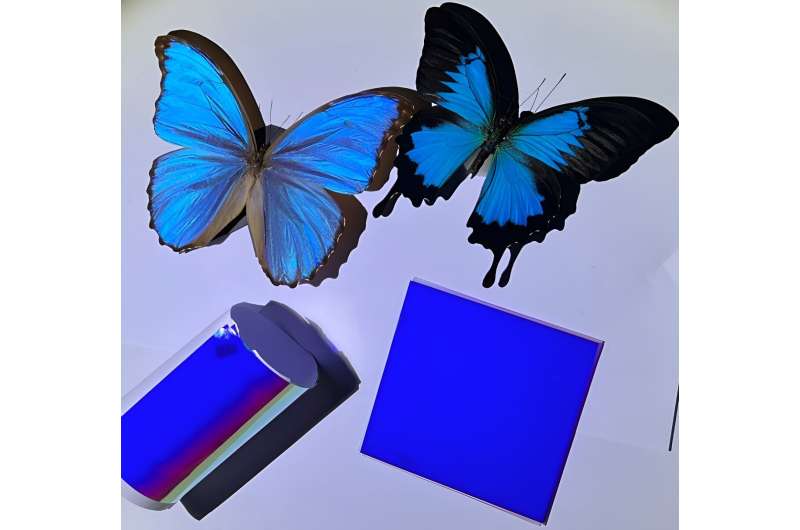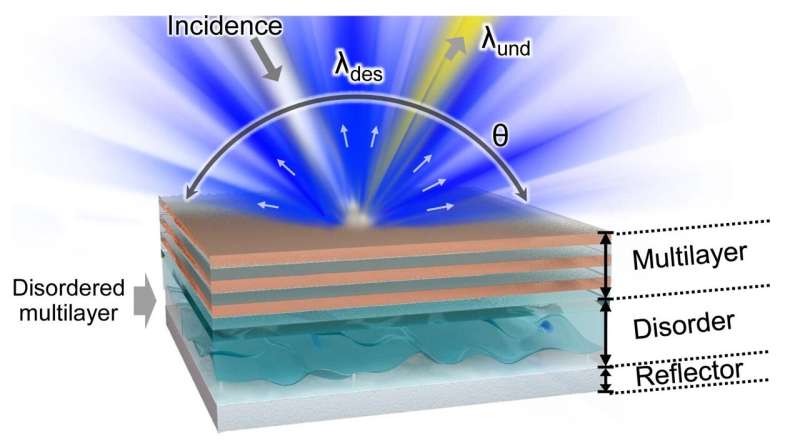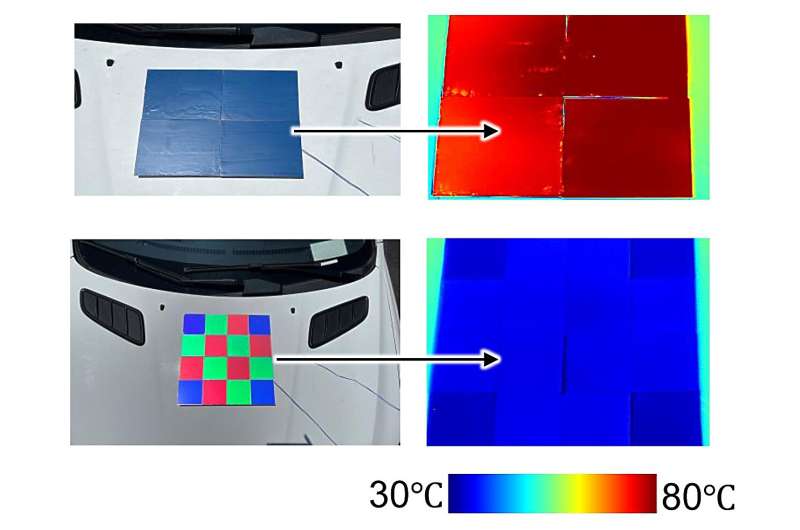This article has been reviewed according to Science X's editorial process and policies. Editors have highlighted the following attributes while ensuring the content's credibility:
fact-checked
peer-reviewed publication
trusted source
proofread
Butterfly-inspired films create vibrant colors while passively cooling objects

On a hot summer day, white clothing feels cooler than other colors due to reflecting—not absorbing—sunlight. Other colors like blue or black, will undergo a heating effect as they absorb light. To circumvent this heating effect in colored cooling films, researchers drew inspiration from nanostructures in butterfly wings.
The new films, which don't absorb any light, could be used on the outside of buildings, vehicles and equipment to reduce the energy needed for cooling while preserving vivid color properties.
"In buildings, large amounts of energy are used for cooling and ventilation, and running the air conditioner in electric cars can reduce the driving range by more than half," said research team leader Guo Ping Wang from Shenzhen University in China. "Our cooling films could help advance energy sustainability and carbon neutrality."
In Optica, Optica Publishing Group's journal, the researchers show that the films they developed lower the temperature of colorful objects to about 2°C below the ambient temperature. They also found that when left outside all day, the blue version of the films was approximately 26°C cooler than traditional blue car paint. This represents an annual energy savings of approximately 1,377 MJ/m2 per year.
"With our new films, excellent cooling performance can be achieved, no matter the desired color, saturation or brightness," said Wang. "They could even be used on textiles to create clothes of any color that are comfortable in hot temperatures."
Inspired by nature
A car with blue paint appears blue because it absorbs yellow light and reflects blue light. The large amount of light that is absorbed heats the car. Morpho butterflies, however, produce their highly saturated blue color based on the nanostructure of their wings. The design of the cooling nanofilm mimics these structures to produce vibrant colors that don't absorb light like traditional paint.
To create their Morpho-inspired nanofilms, the researchers placed a disordered material (rough frosted glass) under a multilayer material made of titanium dioxide and aluminum dioxide. They then placed this structure on a silver layer that reflects all light, thus preventing the absorption of solar radiation and the heating associated with that absorption.

The film's color is determined by how components within its multilayered structure reflect light. To create blue, for example, the multilayer material is designed to reflect yellow light in a very narrow range of angles while the disordered structure diffuses the blue light across a broad area.
Although this type of passive photonic thermal management has been accomplished before, it has only been used with white or clear objects because it is difficult to maintain a wide viewing angle and high color saturation.
Passive cooling of colorful objects
"Thanks to the layered structure we developed, we were able to extend the passive cooling method from colorless objects to colorful ones while preserving color performance," said Wang. "In other words, our blue film looks blue across a large range of viewing angles and doesn't heat up because it reflects all the light. In addition, high saturation and brightness can be achieved by optimizing the structure."

To test the new technology, the researchers created blue, yellow and colorless films, which they placed outdoors at Shenzhen University, on surfaces such as roofs, cars, cloth and cell phones, from 9 a.m. to 4 p.m. in both winter and summer. Using thermocouple sensors and infrared cameras to measure temperature, they found that the cooling films were more than about 15 ℃ cooler than the surfaces they were placed on in the winter and about 35°C cooler in the summer.
The researchers point out that replacing the silver film with an aluminum film would make the films less expensive and manufacturable by a scalable fabrication method such as electron beam evaporation and magnetron sputtering. Now that they have demonstrated the cooling and color performance of the films, the researchers plan to study and optimize other properties such as mechanical and chemical robustness.
More information: Wanlin Wang et al, Cooling colors below the ambient temperature, Optica (2023). DOI: 10.1364/OPTICA.487561
Journal information: Optica
Provided by Optica




















